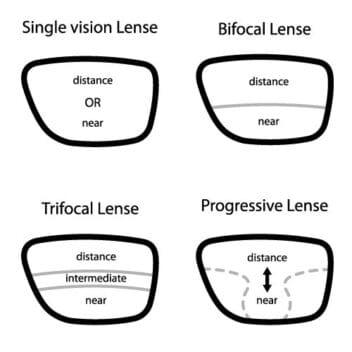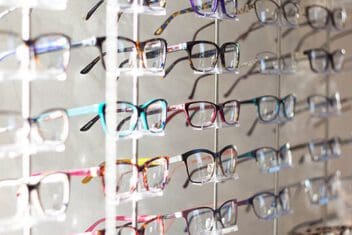Further Reading
Trifocal Glasses vs. Other Options: Which Should You Buy?
Home / Everything About Glasses /
Last Updated:
Trifocal glasses are a type of eyewear that correct for three different ranges of vision on one lens. From top to bottom, trifocal lenses correct for distance, intermediate, and up-close vision problems.
Table of Contents

Trifocal glasses are typically recommended for people over the age of 40 who have a pre-existing vision condition and are starting to experience presbyopia. But anyone who needs help with the three fields of vision could benefit from trifocal glasses.
Trifocals are made by putting three different vision prescriptions on one lens. First, the distance vision prescription is made on the lens, followed by the intermediate vision prescription for the middle of the lens, and then the near vision prescription on the lower portion of the lens.
Trifocal glasses serve a unique purpose compared to other types of glasses. Regular glasses can only correct for one vision prescription. Bifocals correct for just two fields of vision on a lens. Progressives are similar to trifocals, but they can provide a more seamless transition between vision ranges.
The cost of trifocals compared to other types of eyeglasses varies, depending on the level of customization you are looking for and what special options, like lens coatings and frames, you select.
While trifocal glasses are helpful for people with multiple vision problems, there are downsides to them. Difficulty adjusting to the lenses, a lack of full customizable capacity, and a need to replace lenses as your vision changes are some of the drawbacks.
Trifocals are available at most local and online eyewear retailers. If you already have a vision prescription, you can order a pair right away. Otherwise, start by getting an updated vision assessment from your eye care provider.
What Are Trifocal Glasses?
Trifocal glasses have a special lens that provides vision correction in three different ranges of vision: near, intermediate, and distance. A trifocal lens has lines on it that delineate the corrective area on the lens for each range of vision. Because of these lines, vision can be blurred between each focal range.
The top portion of a trifocal lens corrects for distance vision, for activities such as driving. The middle portion of the lens corrects for intermediate vision, which helps for seeing objects at about an arm’s length away. The lower portion of a trifocal lens is for close activities, such as reading.
You deserve clear vision. We can help.
With 135+ locations and over 2.5 million procedures performed, our board-certified eye surgeons deliver results you can trust. Your journey to better vision starts here.

Who Are Trifocal Glasses Best Suited For?
Trifocals are best suited for people who need vision correction at multiple distances. Certain vision conditions can cause people to need trifocal lenses.
Many people develop presbyopia for example, as they age. It is a common condition that typically starts to occur just past the age of 40 and causes people to lose the ability to see clearly close up.
For people who already have an eyeglass prescription for middle or distance vision problems, the development of presbyopia may lend to a need for trifocals. Presbyopia is part of the normal aging process and can cause people to need to change their eyeglass prescriptions. For people who do not wish to wear contact lenses or undergo eye surgery, trifocal glasses are a great way to allow them to continue seeing clearly in all vision ranges.
How Trifocals Are Made
Trifocal glasses are made by creating three distinct vision prescriptions on one lens. If you are getting customized trifocals, you may be able to select the design of each segment.
The two main types of trifocal options to choose from are:
- Flat-top trifocal lens. The near and intermediate vision segments are fit into a D-shape that allows for good peripheral vision. They don’t reach across the whole lens, and they are easy for people to adjust to.
- Executive trifocal lens. The intermediate segment is thinner with this lens. Each segment runs across the whole lens, and a broader range of corrected vision is offered.
To create a trifocal lens, the distance prescription is made on the entire lens first. Following the distance prescription, additional diopters are added on top of the lens until the intermediate prescription is achieved on the rest of the lens. Finally, more diopters are added to the lower part of the lens until the desired near vision prescription is reached.

Trifocals can be made on the following lens materials:
Glass
CR-39
Polycarbonate
Hi-Index
Trifocal Glasses vs. Other Types of Glasses
Trifocal glasses are unique to other types of glasses due to their ability to provide vision correction in three different fields, all in one pair of glasses. Trifocal glasses, however, are not appropriate for everyone.
Other types of glasses include:
- Standard eyeglasses. Standard eyeglasses are the most common type of corrective eyewear prescribed for many different vision problems. A single vision prescription is made on the lens of regular glasses.
- Bifocals. Bifocals provide vision correction at two different fields of vision rather than three, like trifocals. With bifocals, the top part of the lens is for distance vision, and the bottom part is for up-close vision, with a clear line delineating the two prescriptions.
- Progressives. Progressive lenses provide correction for multiple fields of vision with no distinct line across the lenses. The prescription strength progressively increases from top to bottom.
While increasing numbers of people are choosing progressives over trifocals, trifocals tend to offer a better peripheral field of vision than progressives, especially for reading or working on the computer. Additionally, many people find progressives more functional than bifocals or trifocals, but they can be harder to get used to.
You deserve clear vision. We can help.
With 135+ locations and over 2.5 million procedures performed, our board-certified eye surgeons deliver results you can trust. Your journey to better vision starts here.
Cost Differences
The cost of your eyeglasses will vary depending on how much customization you need, what types of frame and lens coating you prefer, and where you choose to buy your glasses. In general, however, multifocal lenses are more expensive than regular glasses with a single vision prescription.
Reasons that multifocal lenses cost more include:
- Materials. High-definition lenses, which are the most expensive, provide the sharpest vision and most peripheral vision for people with complex eye conditions that require a multifocal lens.
- Design. The design of a trifocal or progressive lens is much more complex than a single vision or bifocal lens, making it more expensive.
- Coatings. Extra cost is added for specialized coatings, such as on adaptive progressive lenses.
- High-end options. If you have specific vision prescription needs, high-end (and more expensive) lenses can be customized to accommodate unique vision requirements.
- Brand name versions. Brand name frames and lenses typically cost more than generic glasses. Similar quality glasses can be found at lower prices from less well-known companies.
If you need multifocal lenses and are concerned about the high cost, remember that there are ways to save, even on customized glasses. While some features should not be skimped on, such as the lens material and design, you can save money elsewhere by selecting less expensive coatings and going with generic frames.

Downsides to Trifocals
While there are many benefits to wearing trifocal glasses, there are also a few disadvantages. One of the most common complaints about trifocals is that they are difficult to get used to. Because of the three distinct vision prescriptions on a trifocal lens, it can feel like images are jumping around as your eye moves from one prescription level to the next.
Another complaint about trifocals is that they appear to be a sign of aging. Because of the three distinct vision prescriptions marked by lines on your lenses, someone looking at you with your glasses on can see that you are wearing trifocal glasses. Because of this, some people prefer progressive lenses for a more youthful look.
Additionally, trifocals aren’t as customizable as progressive lenses. Your vision prescriptions for near, intermediate, and vision distance can be customized, but the lenses typically only come in a couple of standard options.
Finally, trifocal glasses only last as long as your vision prescriptions stay the same. If your vision changes, you might need to get updated prescriptions, which would call for new lenses. Fortunately, replacement lenses are available at affordable prices.
Where to Buy Trifocals
If you’re considering purchasing trifocal glasses, it’s essential to explore your options carefully. While online retailers like Amazon and Walmart offer a wide variety of eyewear, including trifocals, we strongly recommend starting your journey by consulting with your trusted optometrist or eye care provider.
They can assess your current vision prescriptions, discuss your specific vision needs, and recommend the most suitable lens options for you. Your optometrist’s expertise ensures that you receive personalized guidance tailored to your unique vision requirements.
Popular Brands of Trifocal Lenses
As you consult your eye surgeon or optometrist about your cataract surgery, you should also inquire about the best cataract lens and various brands available. Your eye surgeon will consider the power and type of lens to use to correct your vision problem.
While you may not have much to say about the lens’ power, you can influence your surgeons’ decisions about the brand. Some of the best trifocal lens brands include:
- Rayner lens
- Aurolab
- Locare
- Zeiss
- Appasamy
- Hoya lens
- Johnson and Johnson
- Alcon
Note that different brands price their trifocal lenses differently.
You deserve clear vision. We can help.
With 135+ locations and over 2.5 million procedures performed, our board-certified eye surgeons deliver results you can trust. Your journey to better vision starts here.
References
- 5 Reasons Progressive Lenses Cost More. (August 2017). Multifocals.
- Eyeglasses and Contact Lenses. University of Rochester Medical Center.
- Trifocal. Glasses Crafter.
- Types of Progressive Lenses. (July 2019). Verywell Health.
- What Is Presbyopia? (January 2020). American Academy of Ophthalmology.
- What is the Difference Between No-Line Bifocals, Progressive Bifocals and Trifocals? (January 2013). American Academy of Ophthalmology.
This content is for informational purposes only. It may have been reviewed by a licensed physician, but is not intended to serve as a substitute for professional medical advice. Always consult your healthcare provider with any health concerns. For more, read our Privacy Policy and Editorial Policy.